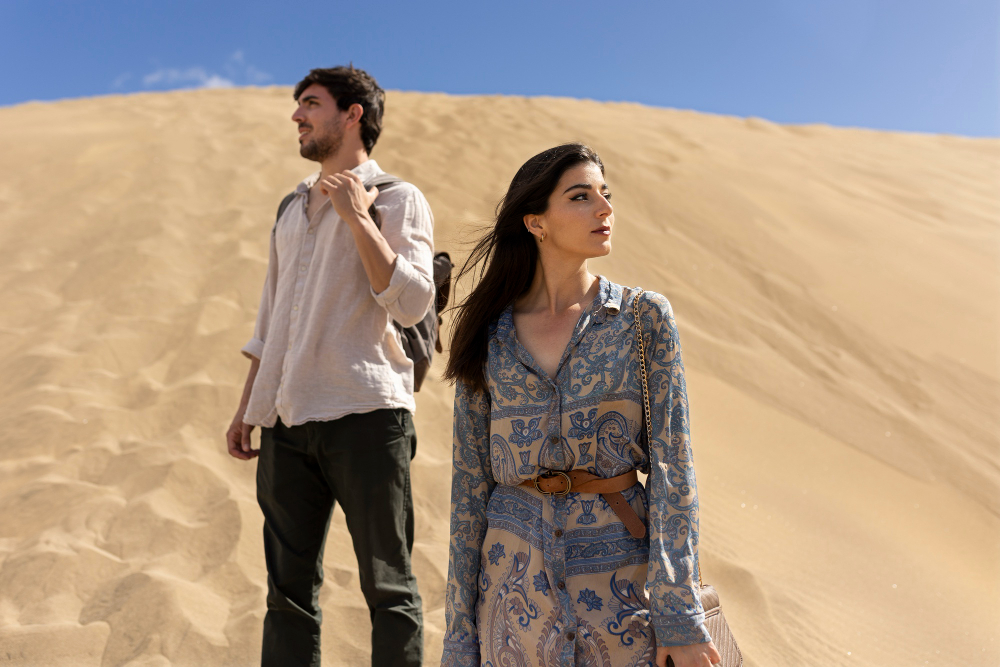Deserts are some of the most extreme environments on Earth — scorching hot by day, freezing by night, and often relentlessly dry. Whether you’re hiking, traveling, working, or simply exploring, choosing the right desert clothing can make the difference between a safe, comfortable experience and a dangerous one.
The right gear helps you stay cool in high temperatures, protects your skin from UV radiation, and guards against dehydration and sand exposure. This guide will cover everything you need to know about what to wear in hot, dry, and harsh environments — from material choices to color selection, layering, and accessories designed for the desert’s unique challenges.
Understanding Desert Conditions
Deserts vary in temperature and terrain. The Sahara and Arabian deserts, for example, can reach daytime temperatures above 45°C (113°F), while the Atacama or Mojave can drop below freezing at night.
Desert environments are characterized by:
- Intense sun exposure
- Low humidity (causing rapid dehydration)
- Dust and blowing sand
- Large temperature fluctuations between day and night
Clothing in these conditions must balance sun protection, breathability, and adaptability.
The Science of Desert Clothing
In extreme heat, your body’s main goal is to regulate temperature. Desert clothing must:
- Allow air circulation for evaporative cooling.
- Reflect sunlight while shielding from UV rays.
- Protect from abrasion and dehydration.
Contrary to popular belief, long sleeves and loose fabrics are better than short clothing in the desert. Covering up keeps skin temperature lower and prevents sunburn and moisture loss.
Best Fabrics for Desert Environments
Choosing the right fabric is crucial. Not all breathable materials perform well in dry heat.
Recommended Fabrics:
- Cotton: Breathable and comfortable for light activities. Absorbs sweat, which helps cool the body as it evaporates.
- Linen: Extremely breathable, lightweight, and ideal for casual desert travel.
- Merino wool: Naturally regulates temperature, wicks sweat, and resists odor. Excellent for layering in variable temperatures.
- Technical synthetics (nylon, polyester blends): Common in desert hiking and military clothing. Lightweight, moisture-wicking, and quick-drying.
Avoid:
- Thick denim or leather: They trap heat.
- Pure polyester (cheap versions): Can cause overheating and discomfort.
Choosing the Right Colors
Color matters more than most people think.
- Light colors (white, beige, khaki) reflect sunlight and help stay cool.
- Earth tones are useful for blending with the environment and hiding dust.
- Dark colors may absorb more heat but can offer better UV protection in certain fabrics.
For most desert travelers, light neutral shades are the ideal balance of visibility, comfort, and practicality.
Desert Tops and Shirts
Your upper body is most exposed to the sun, so protection is essential.
Features to Look For:
- Long sleeves with roll-up options.
- UPF (Ultraviolet Protection Factor) rating for built-in sun protection.
- Vented backs and armpits for airflow.
- Moisture-wicking and quick-drying properties.
Recommended:
- Button-up sun shirts made of nylon or polyester blends (like Columbia’s Omni-Shade series).
- Lightweight merino wool shirts for trekking or desert camping.
Avoid sleeveless tops — they expose too much skin and increase dehydration risk.
Desert Pants and Bottoms
Pants in desert environments should protect against sun, thorns, and blowing sand.
Ideal Features:
- Convertible pants (zip-off legs) for versatility.
- Loose-fitting for airflow.
- Reinforced knees for durability in rocky areas.
- Lightweight and breathable fabric.
Cotton or nylon-blend hiking pants are ideal. Avoid tight jeans or leggings; they trap heat and restrict airflow.
For sand dunes or desert treks, gaiters can help keep sand out of your shoes and socks.
Footwear for Desert Terrain
Desert terrain can range from soft dunes to rocky trails and hot sand. The right footwear prevents blisters, burns, and fatigue.
Best Options:
- Breathable hiking boots with ankle support.
- Ventilated desert boots used in military and expedition settings.
- Trail running shoes for light desert hikes.
Tips:
- Avoid open sandals in deep sand or rocky deserts — they expose feet to burns and abrasions.
- Use moisture-wicking socks (merino wool or synthetic).
- Gaiters protect from sand intrusion and insects.
Remember: feet swell in high heat, so ensure a half-size larger fit for desert footwear.
Essential Desert Accessories
Accessories are not optional in the desert — they are life-saving.
Must-Have Items:
- Wide-brimmed hat or shemagh: Protects face, neck, and ears from direct sun.
- Sunglasses with UV protection: Prevents eye strain and damage from glare.
- Neck gaiter or scarf: Shields the mouth and nose from sandstorms.
- Lightweight gloves: Useful for desert driving or handling hot gear.
- Hydration packs or water bottles: Staying hydrated is non-negotiable.
A camelback system (hydration bladder) is ideal for long treks, ensuring constant access to water.
Layering for Day-Night Temperature Swings
Desert temperatures can drop by 20–30°C (36–54°F) at night. While daytime requires cooling gear, nighttime demands insulation.
Daytime Layer:
- Lightweight, moisture-wicking base.
- Breathable, long-sleeved outer layer.
Nighttime Layer:
- Fleece or lightweight insulated jacket.
- Optional thermal base layer in cold deserts.
Layering keeps your temperature regulated without overheating during transitions.
Cultural and Practical Considerations
In many desert regions (North Africa, the Middle East), traditional desert clothing has evolved for a reason — it works.
- Loose robes and tunics (like the djellaba or thobe) offer airflow and full coverage.
- Head coverings (like the keffiyeh or shemagh) protect from sun, sand, and wind.
- Closed, breathable footwear is worn even in extreme heat for safety.
When traveling, dressing respectfully according to local customs is both practical and culturally considerate.
Conclusion
Desert clothing is about more than fashion — it’s about survival, comfort, and respect for the environment. The key principles are simple:
- Cover up rather than expose.
- Choose breathable, light fabrics.
- Prioritize UV and sand protection.
- Layer smartly for temperature changes.
With the right clothing and preparation, you can confidently face any desert — from the blazing Sahara to the dusty Mojave — safely and comfortably.
FAQs
1. What fabric is best for desert clothing?
Linen, cotton, and lightweight technical synthetics are ideal. They are breathable, help wick moisture, and protect from sun exposure.
2. Why do desert people wear long clothing?
Long, loose clothing protects the skin from sunburn, sand, and dehydration by reducing direct sun exposure and retaining a micro-layer of cool air near the body.
3. What colors are best for desert wear?
Light colors like beige, tan, and white reflect sunlight and keep you cooler. They also blend naturally with desert environments.
4. Do I need special shoes for desert travel?
Yes. Breathable hiking boots or desert boots with ankle support and gaiters work best to prevent burns, blisters, and sand intrusion.
5. How can I stay cool and hydrated in the desert?
Wear loose, moisture-wicking clothing, protect your head and neck, drink water frequently, and avoid excessive physical activity during peak sun hours (10 AM–4 PM).
Also read: Brown Recluse Washington State: How to Identify and Stay Safe




Leave a Comment